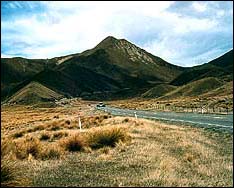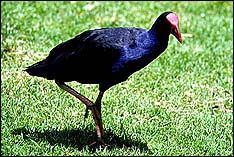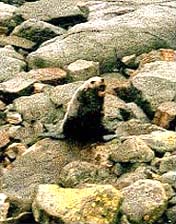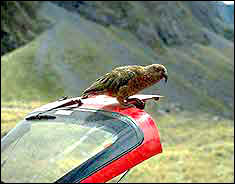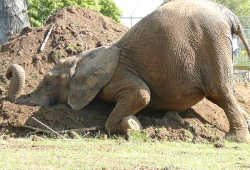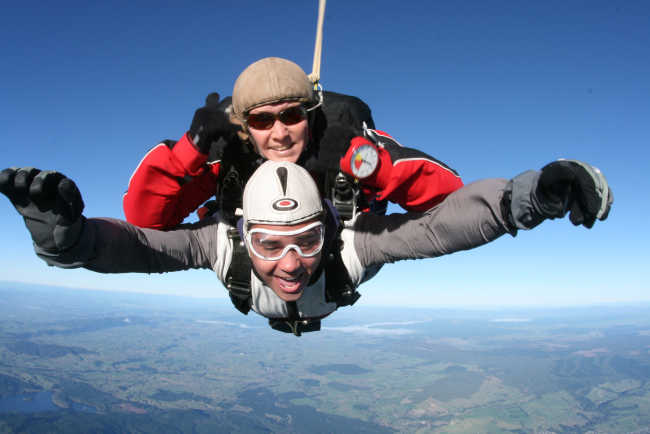Wendy Gallagher – 07/12/01
|
|
| A typical highway scene through the South Island’s Central Otago. Photo source Peter Hunt |
Summer is here. People who want to take advantage of warm air and sunshine will be thinking about taking road trips. Whether it’s for a Sunday drive for ice cream or a weekend away somewhere, more people will be on the roads, and as it’s breeding season for many species there will be wildlife to watch out for near the southern roadsides. So what can you expect to see from the glass eyes of your rubber wheeled metal beast, and how much do you really know about the creatures you will see? I have provided a brief profile of some of the wildlife you may encounter on your travels. Plains and pasture Driving through farmland you will come across a variety of wildlife including spur winged plovers, white faced herons, and magpies playing roadside roulette and taunting cyclists. One of the most common birds you will see at ground level is the pukeko, and in the air you will see the Harrier hawk. Pukeko Gangly yet beautifully coloured with its bright indigo feathers, glossy black wings, and vivid red beak and legs, the pukeko is a member of the same family as the weka. Estimated to have been in New Zealand for approximately 1000 years, numbers of the native pukeko have increased as forest land has decreased.
|
|
| Pukeko Photo source Jim Steinhart with permission from http://www.planetware.com |
Some drivers will unfairly dismiss this bird as either stupid or suicidal, but the reason we see them so close to the road is because there are often drains running alongside farmland where there is a good source of food. An omnivorous bird, pukeko mainly feed on pasture or swamp vegetation, but will also include insects, small birds, frogs, and sometimes eggs in their diet. Pukeko breed in August through February. They are communal birds where both male and female adults, breeding and non-breeding, will all take part in raising chicks. Although normally seen by the roadside alone, I have on rare occasions spotted pukeko in pairs and with chicks. Apart from the obvious danger from vehicles, pukeko fall under attack from Harrier hawks. Birds form a group and create a cacophony of sound to ward off the attacks. The same method is used against rats and stoats that try to plunder their nests, and pukeko have been known to collectively chase these enemies away. Pukeko can run quite fast and swim well, but they are clumsy when it comes to flying and can manage only short distances. Harrier hawk Harriers peruse the roadsides hoping for an easy snack provided by unsuspecting rabbits, possums, ferrets and other birds, who have experienced a fatal encounter with a vehicle. Unfortunately, sometimes the hawks end up as road kill too. As well as carrion, harriers will eat the young of pukekos and ducks, and prey upon rodents found in fields. They also raid the nests of other birds. Breeding takes place from June through February. Spectacular aerobatics are performed during the mating ritual. Nests are made on the ground from flax and grass in wetland areas. Females sit on the nest while the males hunt for her and the chicks. Chicks leave the nest at around three weeks, and will fly when they are approximately six and half weeks old. Young birds have dark eyes and plumage, which lightens with age. I have noticed these colour variations on low flying hawks from my car window. Endemic to New Zealand, the Harrier hawk was once hunted for bounties until protection was granted in 1985. Coastline
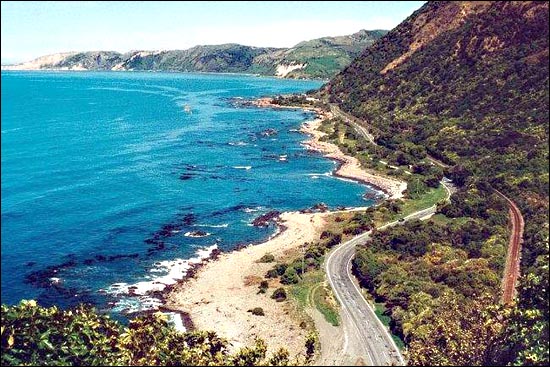 |
| South of Kaikoura looking toward the Amuri Bluff. |
Many travellers following the South Island’s East coast will come across Kaikoura, a seaside town where you can expect to see the Pacific in a variety of moods depending on the weather. Sometimes it sparkles with a thousand tiny mirrors of sunshine floating on an azure saturated surface. At other times the sea will seem a dark seething green, the wind wailing across the top of its stormy depths. Whatever the weather the coastline is always spectacular. It is home to many birds such as albatross, penguins, cormorants, gulls and gannets, and the New Zealand fur seal, which can easily be seen from the road lazing around in rocky areas. Viewing is particularly good north of the Kaikoura township at Ohau Point. New Zealand fur seal Pull over to the side of the road for a closer look, and you will find these seals amiable enough to photograph. Some even seem to pose rather proudly when the camera comes out.
|
|
| New Zealand fur seal Photo source Wendy Gallagher |
Hunted for around 1000 years, almost to extinction, the New Zealand fur seal was granted protection in 1894, and is covered under the Marine Mammals Protection Act. Diet consists of squid, octopus, anchovies, lanternfish, hoki, and sometimes penguins. Feeding takes place mostly at night when their prey rise to the surface after spending the day deep underwater. Dives can last for up to six minutes with an average time of one minute, and diving depths of over 200m can be reached. The seals live in groups called colonies, choosing rocky places with enough shelter to raise pups. Territory is established by male seals (bulls) around November when they collect approximately seven females into a ‘harem’. Males weigh anywhere between 120-180 kgs and females between 30-50 kg. Females give birth after nine months gestation to one pup each in early December. Sharks, orca, leopard seals, and sea lions prey upon seals. They are also susceptible to pollution, and of course, man. Some fishermen consider seals pests who compete for the same catch. All too often however, seals come off second best when they are found drowned in a fishermen’s net. Despite these threats, populations of seals exist in healthy numbers up and down the coastline making for great sightseeing from your car window. Mountain and forest regions
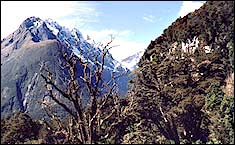 |
| Kea country Click here for a larger version |
In areas around Mt Cook, Queenstown, and Fiordland, there are misty mountains, towering snow capped alps, and ancient rainforests. Along these roads are many walking tracks where native birds such as wood pigeons, bellbirds, weka and fantails can be seen and heard. The most curious, sociable and often troublesome creature you will see is the Kea. Kea (Mountain parrot) Endemic to the South Island, the kea is a highly intelligent, curious, social, and adaptable bird. These characteristics are all vital for survival in the harsh environments they live in. A world population is estimated at less than 5000. Keas nest among boulders in high altitude forest or tussock land, where two to four eggs are laid. Breeding takes place from July through to January. In the wild, searching for food takes up most of a kea’s time. They eat mostly vegetation including fruit, but also dine on grubs and insects. In coastal areas they have been known to kill and eat young mutton birds. In winter when food is scarce, keas have been known to feed on the fatty internal organs of dead and live sheep in the high country. Full protection granted in 1986 meant that farmers were no longer allowed to shoot kea thought to threaten livestock.
|
|
| Curious kea Photo source Virtual New Zealand http://www.vnz.co.nz |
Farmers are not the only people keas have trouble with. Their curious nature leads them to come into contact with skiers, trampers, and other tourists. The powerful and destructive beak on window wipers and the rubber around car windows has damaged many a visitor’s vehicle. DOC have introduced a banding programme to help identify problem birds so they can be removed. Kea are New Zealand’s version of Yogi bear, and groups of them have been seen around public places at Mt Hutt, Fiordland and Milford sound, where they are usually on the look out for tasty fatty food left by humans. They have also been spotted at refuse pits. On your travels please remember that keas are wild animals and should remain that way, so don’t offer them any food. Keas who become reliant on human food may suffer from malnutrition and could die. Despite the trouble keas get themselves into, they are a striking creature and a treat to watch. With their striking green plumage and bright orange colour under their wings, they make a stunning photograph; that is if you’re quick enough to catch them with the camera as they don’t keep still for very long. Take time this summer to look around while out on the roads, and although you may not always drive on roads classified as scenic, or through famous tourist routes, there will always be something to see should you decide to pull over, even if just for a short break in your journey.

